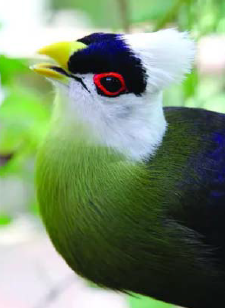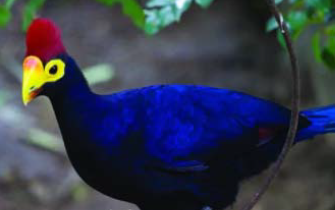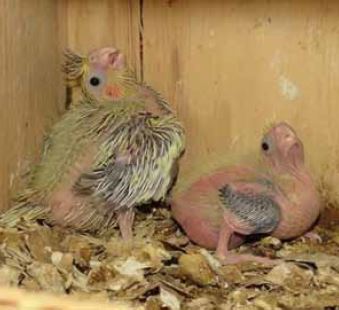Turaco breeding: Loerie, Keeping, Nest box, Feeding
Turaco breeding: Almost without exception, people admire the beautiful Turacos, “Loeries” we used to call them; for example the beautiful green Knysna Loerie and in Kwa-Zulu Natal we have the Purple-crested Loerie.
Introduction
These birds are not only beautiful, but they are also interesting with regards to the pigments in their feathers. The red pigment, turacin, especially visible in their flight feathers, is a pigment that has been shown to contain 5%-8% copper, unique amongst birds and animals. The other thing is that the green in the body feathers is not caused by the refraction of light, as is the case with other birds, but is also a copper-based green pigment called turacoverdin which is not found in any other living creature.
Another thing that makes the Turacos unique is that their feet are zygodactylous, a big word that means that their outer toe can go backwards, similar to a parrot’s when perching, or forwards like a dove’s.

Description
Normally the outer toe is held at right angles.
The above two species are birds of the forests or riverine forest and thick bush. The third species in our region is the “Go-way” bird or Grey Turaco. This bird does not have the unique red and green pigments found in the above two species. No doubt its grey-brown colour is better camouflage in its dry bushveld habitat than the bright greens and reds of the other species.
In aviculture
Turacos are a must-have for any softbill enthusiast, and if they are cared for correctly they do very well in captivity. One of our local breeders, Mossie Webber, has kept this family of birds for twenty years and at present keeps twenty species and subspecies in his collection, including three species of Grey Turacos. Not only does Mossie keep these birds but he has become very successful at breeding them. In 2008 he reared 72 babies, most by hand. In 2009 46 babies were parent-reared, a fantastic achievement.
Turacos can be ringed at about 3 weeks old as they are leaving the nest with aluminum closed rings, size ‘S’ for White-cheeked, Hartlaub’s, Black-billed, Fischer’s, Schalow’s, Red-crested, Purple-crested and Green-crested Turacos; size ‘T’ for Violaceous and Lady Ross. Split plastic-coloured rings can be used to mark adult birds.
Turaco breeding: Housing
Keeping our local (indigenous) Turacos is great, with the only hassle being that you need to apply for permits to keep them as they are indigenous. Due to this, the Turacos from other parts of Africa which are not indigenous can be kept, bred and sold freely without the worry of permits, making those particular species more desirable in South African aviculture.
It has been recommended that the best Turaco breeding species to start with is the White-cheeked Turaco (leucotis). This species seems to be fairly hardy and less susceptible to disease. They are not aggressive to each other and breed readily.
Most Turacos seem to adapt well to captivity. However, they are very territorial, especially in captivity. Mossie has found that the green Turacos (Tauraco family) adapt and breed well as long as their feeding and behavioural needs are met: that is, not more than one pair per aviary. His aviaries for these species are 3m long x 1m wide x 2.10m high. The first meter is a shelter with solid sides, back and roof. The front of the shelter has a partition that starts at the roof and extends down about 400mm.
This is probably the most important part of the design. The wire platform on which the birds build their nests is fixed behind this partition and this hides the nest from any observer at the front of the aviary. The flights then are partly covered by creepers. These aviaries are used for the green and purple families of Turacos and should be considered to be the minimum size for a single pair. Successful European and American breeders speak of aviaries from 5m long x 1.2m wide x 2m high as a minimum. Perches at either end, with a gap in between, will encourage the birds to fly.
Turacos are arboreal (though relatively weak fliers), and natural perches of diameters ranging from 2.5 to 4cm (1.0 to 1.5in) along which birds can run, and between which they can jump, are provided throughout aviaries.
Several perches should be under shelter allowing both members of a pair to perch apart from each other (turacos do not maintain close bodily contact when at rest). Perches exposed to the elements provide the opportunity to sun- and rain-bathe.
Though most turacos will descend to the ground to feed, elevated feeding platforms are recommended for the birds’ convenience and to restrict incursions of rodents, ants, or ground birds; these are best placed under shelter.
The Grey Turacos and Plantain-eaters Mossie have found need much larger aviaries. Fortunately they tolerates other birds in the aviary (as long as they are not of the Grey Turaco family) and Mossie has a large Mulberry tree growing in each of these aviaries where there are fruit pigeons and other birds sharing the aviary with a pair of Grey Turacos.
Because Turacos are so territorial one even must monitor the behaviour of pairs in the smaller aviaries. Bonded pairs that have bred before may begin a vicious fight, usually the male attacking the female. If they are not separated immediately the attacked bird, usually the hen, will be killed. In large, planted aviaries it may be possible for the hen to get away from the male. When such an attack occurs, Mossie separates the pair for a couple of weeks before trying them together again.
Turaco breeding: Nest box
Turaco breeding nests tend to be flimsy, similar to those constructed by doves; but like doves, turacos readily accept artificial platforms. Produce flats, wood and wireframes, or wicker baskets may be used – dimensions should approximate 31 x 43 x 8cm high. Care should be taken that smooth interior bottoms are covered with wire mesh or securely fastened twigs to prevent loosely rolling eggs or chicks’ splayed legs if birds displace nest lining.
Initially, artificial nests should be situated high in aviaries and under shelter if possible, or placed as closely as possible to a site the birds have chosen themselves. Some birds (particularly recent wild imports) may carry token natural nest material to the site, but most eventually accept artificial arrangements.
To encourage shy pairs and to reduce disturbance from adjacent birds, visual screens (e.g. foliage) may be placed around nests situated high in aviaries. Following several successful nestings, platforms may be lowered to more accessible levels and barriers removed. Roofed nest boxes are used in some collections, and these have occasionally proven helpful in inducing nesting by pairs in which one bird is prone to attack the other, as the roof offers some seclusion to the nest occupant.
Feeding
As Turacos are arboreal frugivores, a large part of their diet must be fruit – but not all. Wild fruits are not as sweet, soft and juicy as our cultivated fruits are, so Mossie used a lot of grated apples and added to it chopped banana, grated sweet potato and grated carrots.
Each pair then gets a heaped tablespoon of soaked maintenance pellets; he has also used soaked Mynah pellets.
To soak the pellets Mossie puts six cups of pellets into a bucket and adds four cups of water. He then stirs the pellets to wet them and then lets them stand for half an hour to an hour, until the water has been soaked up.
Mossie also feeds other fruits in season, like grapes and most other seasonal fruits. Pawpaw is especially valuable during the breeding season. A fruit that Turacos absolutely love is figs, both cultivated and wild figs.

Turaco breeding: Conclusion
Turaco breeding is just an introduction to the Turaco family. These birds deserve our attention if they are to survive habitat destruction. If the aviary and feeding are suitable they live for a very long time in captivity with records of birds over twenty years old still producing fertile eggs.


